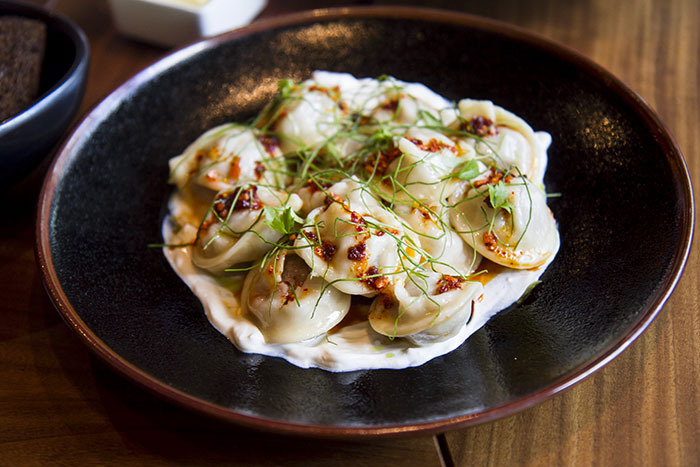
BRICK & MORTAR
CHANNALY PHILIPP/EPOCH TIMES

Pelmeni, traditional Russian dumlings, dressed with chinese-style salsa and crème fraiche.
By By Annie Wu I Epoch Times Staff
When you hear the name Coffeemania, you might not expect it to be a restaurant. And if you had to guess what was on the menu, you might not think that a range of Asian-inflected dishes would appear next to Russian fare like borscht. But if you’re willing to suspend your notions for a moment, you will be happily rewarded.
Coffeemania is a chain from Russia, with 27 locations in Moscow, that initially started as a coffee shop in 2001. In a few years, its success convinced the founders to expand into all-day dining. This January, the chain opened its first overseas location in New York City.
See Coffeemania on D5
Coffeemania
1065 Sixth Ave.
(between West 40th & West 41st streets)
Across from Bryant Park
212-221-2510
Hours
Monday-Thursday
11 a.m.-10 p.m.
Friday
11 a.m.-11 p.m.
Saturday
5 p.m.-11 p.m.
Sunday
5 p.m.-10 p.m.
Breakfast service to come
ARMANDO RAFAEL

Chef Titus Wang often makes use of Asian ingredients in classic dishes.
Coffeemania continued from D1
Right as you walk into the spacious dining room, you’ll know Coffeemania is not just a coffee shop. Designed by a Paris-based firm, the space, featuring modern light fixtures, wooden accents, and high ceilings, gives off a stylish yet casual feel. The space is split between dining tables in the front and a bar in the back, where staff whip up drinks with measured, calculated movements. The noise level inside is surprisingly muted, so you don’t have to strain to hear your dining companions.
Occasionally, you’ll hear murmurs of Russian-evidence of how familiar the city's Rus-sian community already is with the chain. For its New York location, Coffeemania tapped Taiwanese-American chef Titus Wang, (formerly of Annisa, Morimoto, and Delicatessen), whose global influences certainly fit with the city’s personality. Wang instills vigor into each dish by combining multicultural flavors that enhance each other.
Most of the time, he uses Asian ingredients to spice up classics, like roasted marrow, for example. Wang tops the soft marrow with a miso-apricot jam and clam chimichurri, so that, when you slather all those components onto slices of grilled sourdough, you get a happy trifecta of buttery, sweet, and zesty ($18).
In a dish of charred, crunchy Brussels sprouts, Wang adds savory-sweet Chinese sausage, sesame seeds, cilantro, and a tangy chili lime vinaigrette, making these greens highly addictive ($13).
CHANNALY PHILIPP/EPOCH TIMES
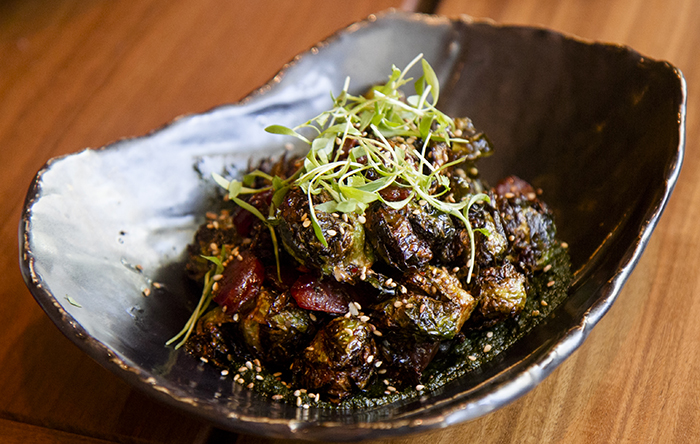
Brussles sprouts with Chinese sausage, sesame seeds, cilantro, and chili lime vinaigrette.
A plate of Josper-grilled chicken wings is equally irresistible. After cooking in a special charcoal-fired barbecue oven, the wings are glazed with a soy honey butter sauce and sprinkled with bits of crispy dehydrated onions. They are finger-licking good ($14).
CHANNALY PHILIPP/EPOCH TIMES
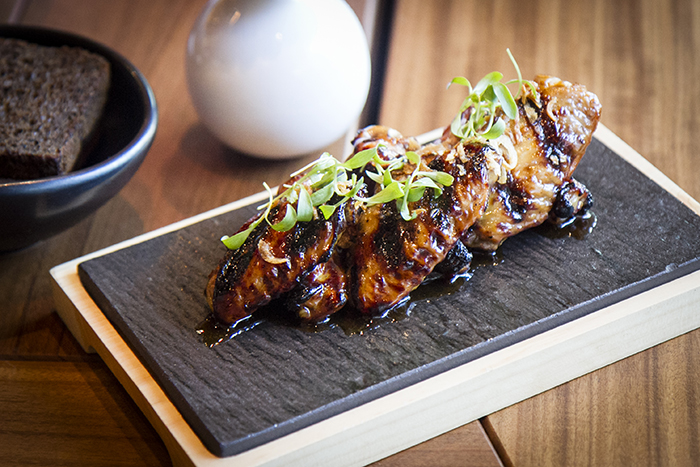
These chicken wings are coated with an addictive soy honey butter sauce.
Wang says his approach is fairly simple. “We work with the freshest products available each season, focusing on how to enhance the main ingredients without being overly complex with sauces and vegetables,” he said, in an email.
Fruit is often used to add a pop of vibrant flavor to dishes. The Berkshire pork chop, for example, is paired with an Asian pear chutney, sesame-cilantro pesto, and bok choy kimchi, which lends just a touch of heat ($35). A dish of seared duck breast, sporting a super crispy skin, is buoyed by a lightly acidic red currant sauce, and a savory garlic-pine nut emulsion ($32).
ARMANDO RAFAEL
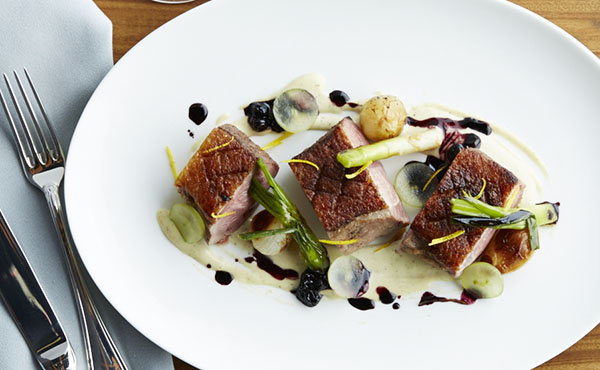
Seared duck breast with red currant suace, garlic-pine nut emulsion, and pearl onions.
Classic Russian dishes are also sprinkled throughout the menu. Bread service consists of a Russian dark rye bread, made with dark . t -1 T. . 4. • • emimmit
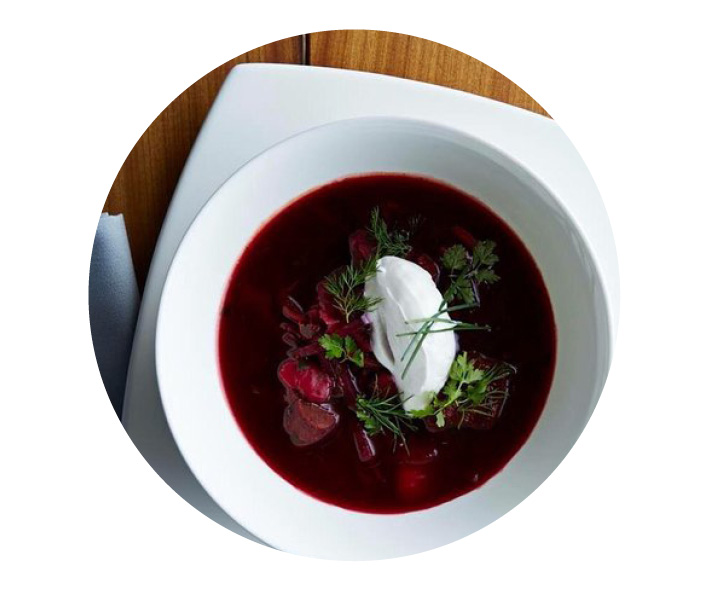
Coffeemani’s take on borscht is light and tangy.
Wang instills vigor into each dish by combining multicultural flavors that enhance each other.
(Below) Coffeemania's take on borscht is light and tangy. (Bottom) Coffeemania's stylish look is designed by . Paris-based firm GBRH.
Given its history as a coffee shop, perhaps it’s no surprise that Coffeemania has an extensive beverage menu consisting of both coffee and non-coffee drinks.
The coffee here isn’t just the typical latte or cappuccino; the barista team has won dozens of Russian and international awards. The Raf, for example, is a velvety mix of espresso and housemade vanilla sugar, made into a frothy and dessert-like coffee drink ($7), while the Latte Singapore is infused with lemongrass fora vibrant pick-me-up ($5 for regular, $7 for large).
Another unusual invention is The Bumble, which combines orange juice, cold-brew coffee, and caramel syrup into a surprisingly delicious drink, a little like caramel candy ($6). With the_Forest_Berry Kenya. the staff draws out the berry notes in the coffee by serving it with a strawberry and raspberry compote that you're meant to taste alongside the coffee ($7).
Other non-alcoholic standouts include a refreshing tarragon soda ($6 for regular, $8 for large) and a bright infusion made from steeped sea buckthorn berries, passion fruit, and ginger ($12 for a pot).
Cocktails are new to Coffeemania; Russians, unlike Americans, don’t typically order cocktails with their meals, and it explains why the bar is in the back of the restaurant. But the cocktail menu is far from an afterthought. Unlike many cocktail menus with a long list of lofty descriptions, Coffeemania's menu is minimalist, belying the care given to each drink.
For a drink as simple as a gin and tonic, for example, the recipe calls for The Botanist gin, made with 22 foraged botanicals in the Hebrides islands. On a recent visit, the bartender slowly poured the gin over a long ice cube that just barely fit into the glass-“waking up” the gin-then topped it off with Fever-Tree tonic water, creating a highly fragrant result ($15). Mean-while, a classic aperol spritz gets a glamorous touch, with an orchid flower garnish and slices of blood orange ($15), while the French 75 ($13) is a refreshing, well-crafted, low-ABV option.
The extensive wine list offers glasses and bottles at a variety of price points.
Desserts are a selection of pastries from different traditions, all made in-house. Especially memorable is the Pannochka, a Russian cake shaped like a ball, with hazelnut cake, butter cocoa cream, and a layer of crunchy biscuit ($10). The Smetannyk is also lovely, with many layers of sour cream ($10). For a fruity treat, the Love Me, Love Me Not bursts with strawberry flavor ($9).